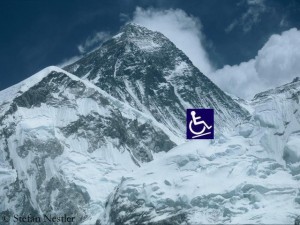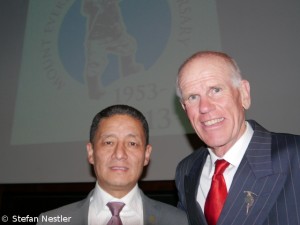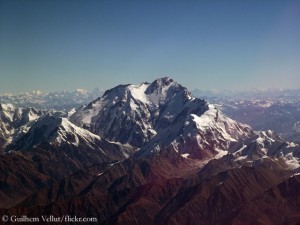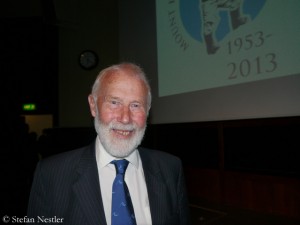Season over on Nanga Parbat?
It has gotten dark. For hours we have been racing with our minibus down the Karakoram Highway to the north. Time to stretch our legs. Near the town of Chilas we stop at a tea room. Some long-bearded men are sitting in front. We start talking. Smalltalk: “How are you?” “Where are you from, where are you going?” Suddenly my mountain guide is gesticulating wildly. I shall get back into our bus quickly. Inside I ask him why he was so excited. “Bad men, dangerous!”, answers my Pakistani companion. Until now I think that he overreacted then, in the summer of 2004. But I remembered this episode again when I was informed about the murder attack on eleven climbers on Nanga Parbat last weekend.
![]() read more
read more
Taking no risks on Nanga Parbat
The Taliban attack on the basecamp at the Diamir side of Nanga parbat has left even Pakistan experts stunned. „We have been caught cold“, Eberhard Andres told me. He is working for the German trekking agency Hauser Exkursionen and is responsible for trips to Pakistan. „It was really the first time that something like this has happened.“ Last weekend Taliban terrorists had attacked the Diamir basecamp and killed eleven climbers: three Chinese, three Ukrainians, two Slovaks, a Lithuanian, a Nepalese and a Pakistani. The attack was of „a completely new quality“, Dominik Müller, head of the agency Amical Alpin, said to me. Swiss expedition organizer Kari Kobler is shocked as well: „We knew that Pakistan can be a dangerous place. But not in the north!“ All of them expect negative consequences for mountain tourism in Pakistan, which had just began to get back on its feet after lean years as a result of the tense political situation.
![]() read more
read more
Terrorist attack on Nanga Parbat
“Killer Mountain” is written on the sign on Karakoram Highway, where you can take a look at the majestic 8000er Nanga Parbat. Actually the sign recalls the numerous tragedies on the “Naked Mountain” in the last century, for example in 1937, when 16 members of a German expedition died in an avalanche. But now the sign has received a new, oppressive meaning. A hit squad penetrated to the base camp on the Diamir side of Nanga Parbat and shot at least ten people. The Pakistani government said the victims were five climbers from Ukraine, four Chinese and a Pakistani guide.
![]() read more
read more
Barrier-free Everest
 A permit for a video interview broadcasted live from the summit of Mount Everest via smartphone costs about $ 2000. We know that since this spring, when the Briton Daniel Hughes did it this way answering questions of the BBC– without permission, as it turned out later. The Nepalese Tourism Ministry was not amused. Hughes could be banned from obtaining climbing permits for ten years or banned from entering the country for five years. But I’m sure that meanwhile both parties have come to an amicable agreement on a special Everest smartphone tariff. How fortunate that I call my old friend Chomolungma from only 50 metres above sea level. Quite legally, only the NSA is listening too. It takes me three attempts to be successful:
A permit for a video interview broadcasted live from the summit of Mount Everest via smartphone costs about $ 2000. We know that since this spring, when the Briton Daniel Hughes did it this way answering questions of the BBC– without permission, as it turned out later. The Nepalese Tourism Ministry was not amused. Hughes could be banned from obtaining climbing permits for ten years or banned from entering the country for five years. But I’m sure that meanwhile both parties have come to an amicable agreement on a special Everest smartphone tariff. How fortunate that I call my old friend Chomolungma from only 50 metres above sea level. Quite legally, only the NSA is listening too. It takes me three attempts to be successful:
Namasté, Chomo! Stefan is calling! Where the hell have you been?
Also Namasté! I was taking a snow shower. Wonderful, this monsoon!
Did you really need a shower after this spring season?
Joker, are you living behind the moon?
![]() read more
read more
Bonington: The pioneers have gone elsewhere
When Everest was climbed first in 1953 Chris Bonington was a young English mountaineer of 17 years. Later he did historic climbs like the first ascents of Annapurna II in 1960, of the Central Pillar of Freney on the south side of Mont Blanc in 1961 and of the 7285-meter-high Ogre in the Karakoram together with Doug Scott in 1977 (the second ascent followed only in 2001). But Bonington also proved to be a great expedition leader. In 1970 he led the successful expedition to the South Face of Annapurna, in 1975 the expedition to Mount Everest, during which Doug Scott and Dougal Haston climbed the Southwest Face first. Bonington himself reached the summit of Everest in 1985 as a member of a Norwegian expedition. He was knighted by the Queen in 1996 for his services to the sport. I met the 78-year-old climber last week at the diamond jubilee celebration of the first ascent of Mount Everest in the Royal Geographical Society in London and asked him – of course – about his thoughts on Everest.
Sir Chris Bonington, 60 years after the first ascent of Mount Everest, how do you feel about these pioneers?
I’m a great believer in the heritage of our sport, looking back, enjoying and learning from what our predecessors have done. In a way that first ascent of the highest point on earth is one of the very, very great occasions. I think it’s story. How they succeeded and worked together, it was a superb team effort. It’s something very special.
![]() read more
read more
Friendship over generations

Jamling Tenzing Norgay (l.) and Peter Hillary
Like their famous fathers Tenzing Norgay and Edmund Hillary, Jamling and Peter are friends and would also be a good rope team. Both followed in the footsteps of their fathers: Jamling Tenzing Norgay (in 1996) and Peter Hillary (in 1990 and 2002) also reached the summit of Mount Everest. Both are continuing the work of their fathers for the benefit of the Sherpas and keep the memory of the two Everest pioneers alive. „My father climbed the mountain and came back down the mountain as a simple man. He lived the rest of his life very humble and simple just like Edmund Hillary”, Jamling said when we met during the Everest Diamond Jubilee Celebrations at the Royal Geographical Society in London. „No two people could have climbed Everest first than Hillary and my father.” Peter Hillary is also proud of the performance of his father and Tenzing Norgay: „For us 60 years later the key thing is what it stands for: Someone does something new. They actually open the door to everyone who follows. These things are very liberating and as a consequence very important.”
![]() read more
read more









Feedback